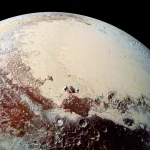Have you ever looked up at the night sky and wondered what’s out there between the planets? While you might know about planets like Mars and Jupiter, did you know that there’s a giant “cosmic junkyard” right in between them? This is the asteroid belt – a region in our solar system that’s full of rocky leftovers from when the planets were forming. Let’s blast off and explore what makes the asteroid belt so interesting, and how scientists think it came to be!
A Busy Neighborhood in Space
The asteroid belt is a vast ring-shaped area located between the orbits of Mars and Jupiter. It’s home to millions of space rocks called asteroids. Some are tiny pebbles, while others – like the largest, Ceres – are big enough to be called dwarf planets.
But don’t imagine the asteroid belt as a packed freeway of crashing rocks! (Even though we’ve used an image like that in this story’s header) In reality, there’s a lot of empty space. If you could fly a spaceship through the asteroid belt, you’d probably pass right by most of the rocks without even seeing one up close. Still, all together, these asteroids hold clues to the history of our solar system.
Leftovers from Planet-Making
So, how did the asteroid belt form? Scientists believe it’s all about leftovers. Around 4.6 billion years ago, well after the theorized Big Bang, our solar system started as a spinning disk of gas and dust. Most of this material clumped together to form the Sun and the planets. But in the region between Mars and Jupiter, things were different.
Jupiter, the giant planet, used its massive gravity to stir up this part of the disk, making it impossible for the dust and rocks to stick together and form another planet. Instead, these pieces remained as smaller objects floating in space – asteroids. So, the asteroid belt is basically a fossil record of what the early solar system was made of!
What’s in the Asteroid Belt?
Asteroids come in all shapes and sizes. Some are made mostly of rock, some are metal, and some even have ice! The biggest asteroid, Ceres, is about 590 miles (950 kilometers) wide and is considered a dwarf planet. There’s also Vesta, Pallas, and Hygiea; each with their own unique features.
Scientists love to study asteroids because they’re like time capsules. Unlike planets, which have changed a lot over time, asteroids haven’t changed much. That means they can tell us what the solar system was like billions of years ago.
Why Does the Asteroid Belt Matter?
Studying the asteroid belt isn’t just about learning space trivia – it helps us understand how planets (including Earth!) came to be. Plus, some asteroids come close to Earth, so keeping track of them can help us protect our planet. Scientists even send spacecraft, like NASA’s Dawn mission, to visit asteroids and bring back information.
Fascinating Facts About the Asteroid Belt
-
It’s not crowded: If you gathered all the asteroids in the belt, they’d weigh less than the Moon!
-
Dwarf planet alert: Ceres is the only dwarf planet in the inner solar system.
-
Metallic wonders: Some asteroids are made of pure metal and could be worth trillions of dollars if mined.
-
Cosmic collisions: Crashes between asteroids sometimes create meteorites that fall to Earth.
-
Space missions: Several spacecraft have visited asteroids, including NASA’s Dawn, which orbited Vesta and Ceres.
Questions to Ponder
-
What do you think would have happened if Jupiter wasn’t located so close to the asteroid belt?
-
Why might asteroids hold clues about the early solar system that planets don’t?
-
How could studying asteroids help us learn more about Earth’s own history?
-
What challenges do you think a spacecraft would face while exploring the asteroid belt?
-
If you could name a newly discovered asteroid, what would you call it and why?
The asteroid belt might seem like just a bunch of space rocks, but it’s really a treasure chest full of clues about where we, and our planet, came from. Who knows what secrets are still waiting to be discovered out there among the stars?


